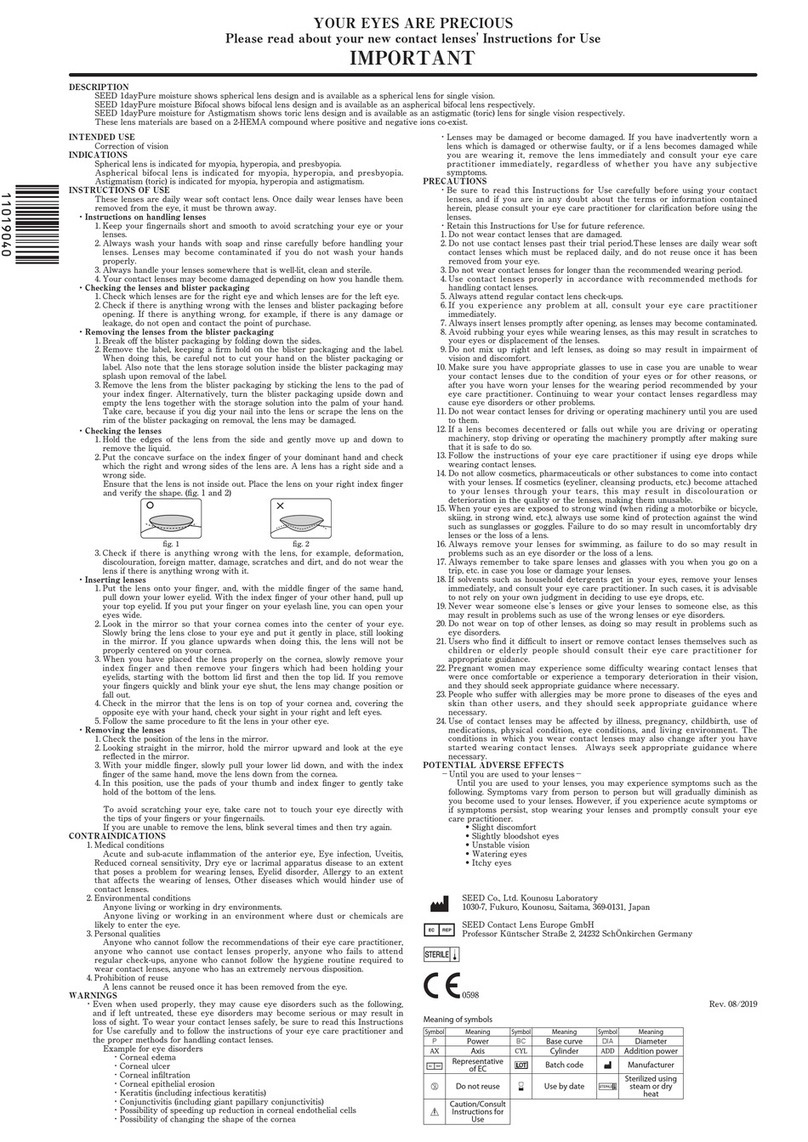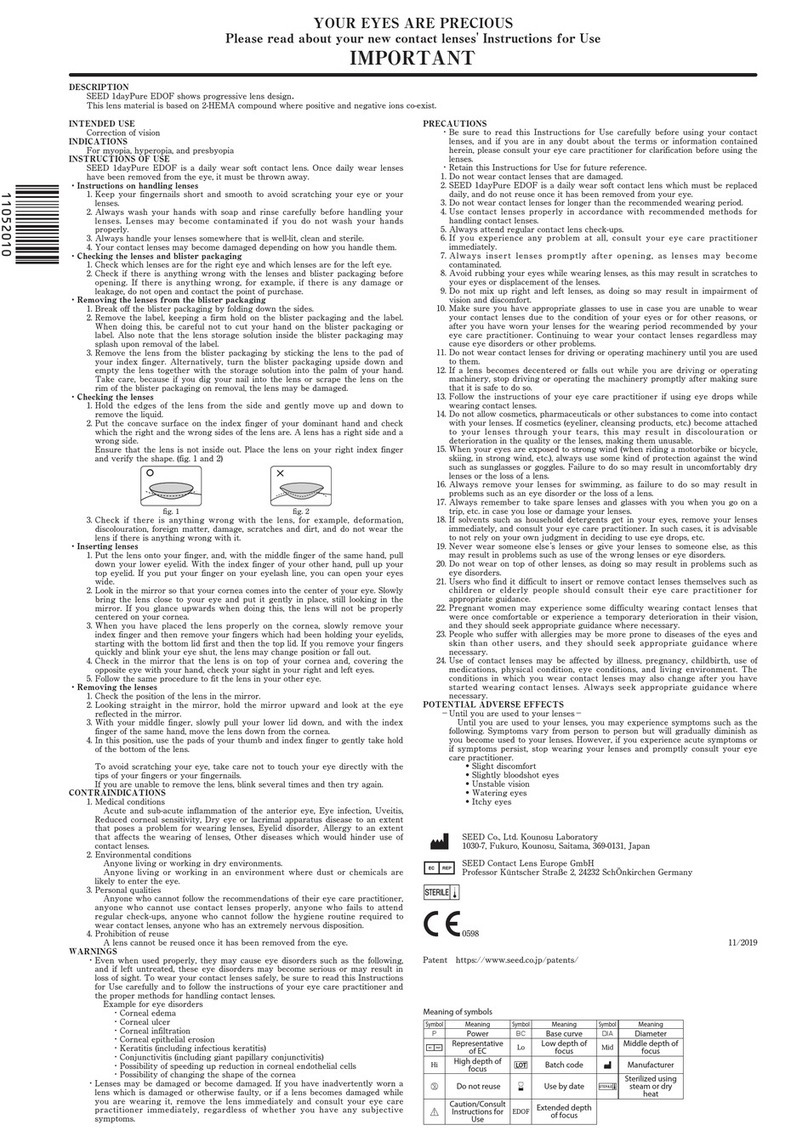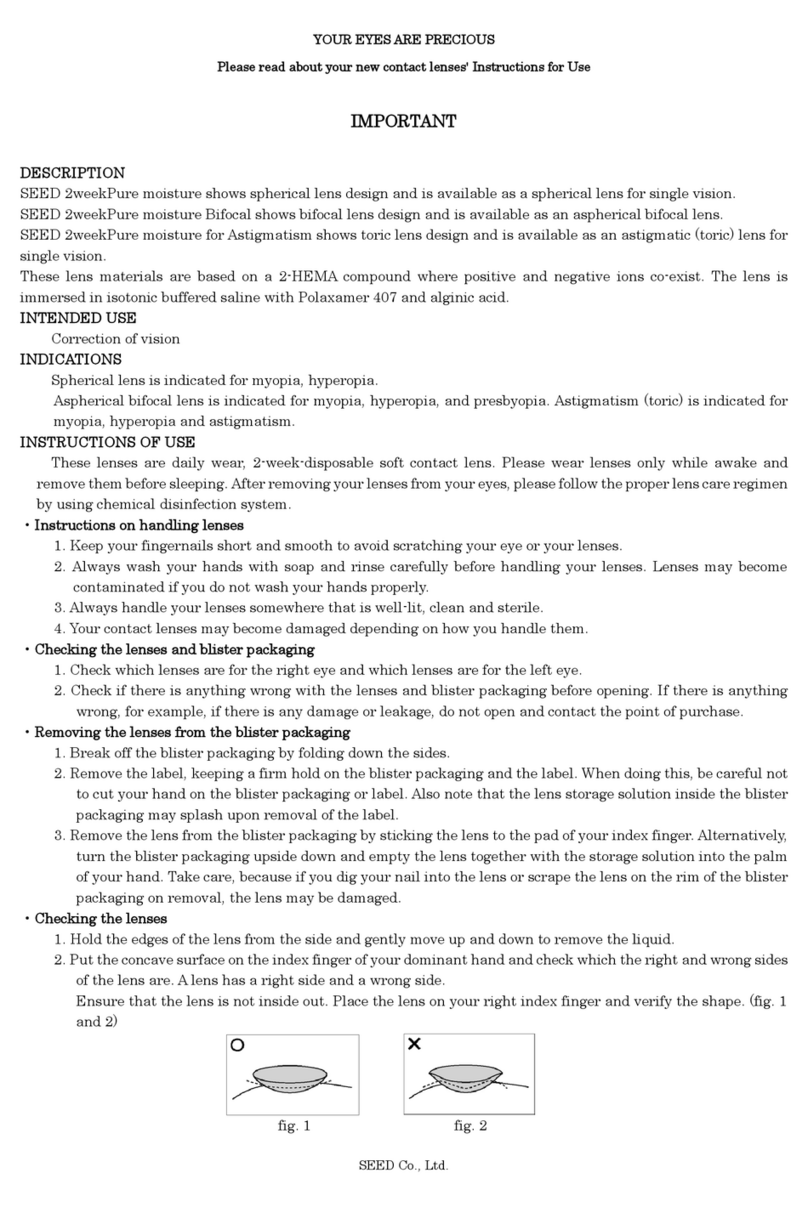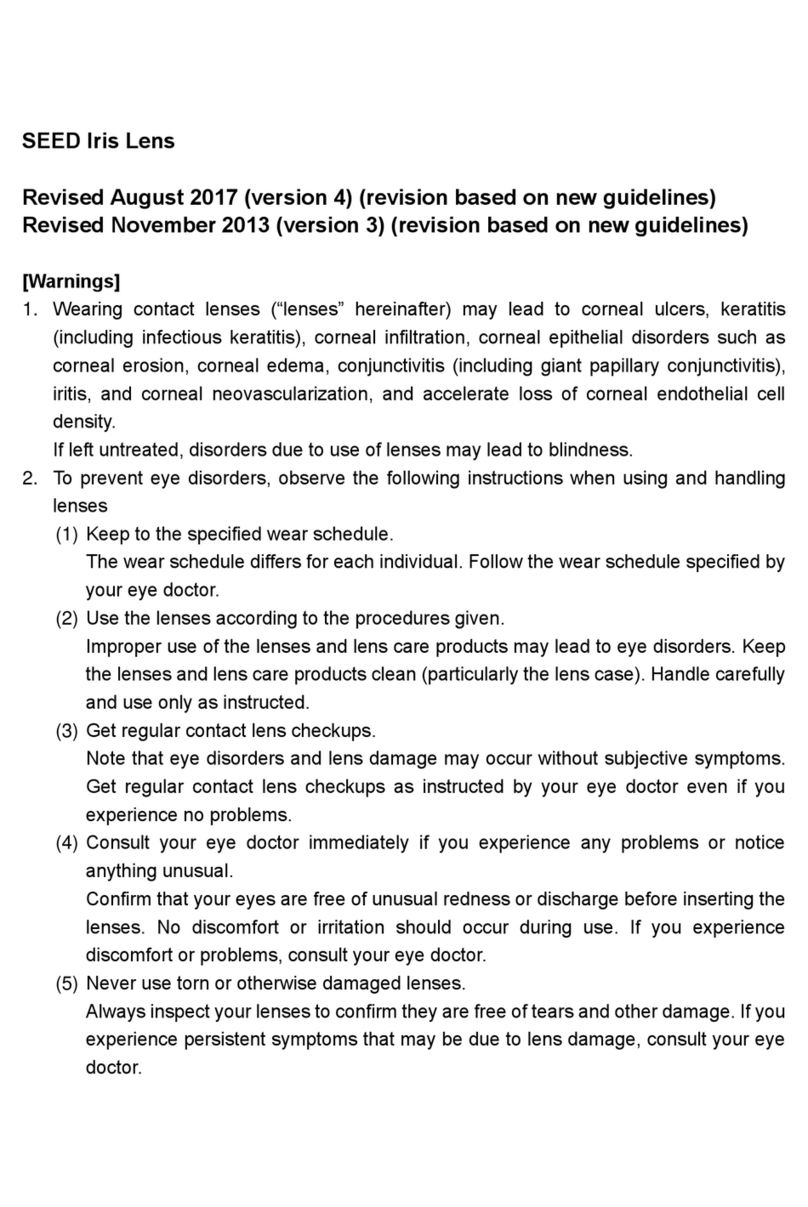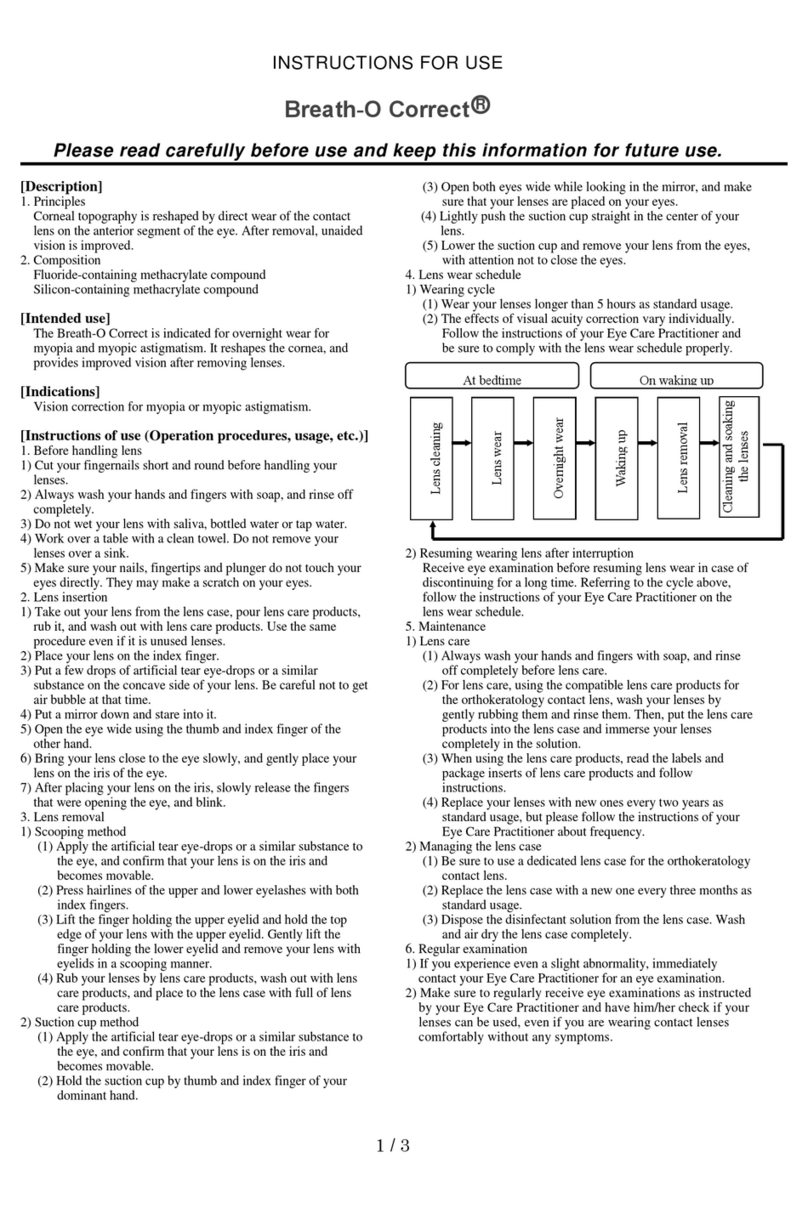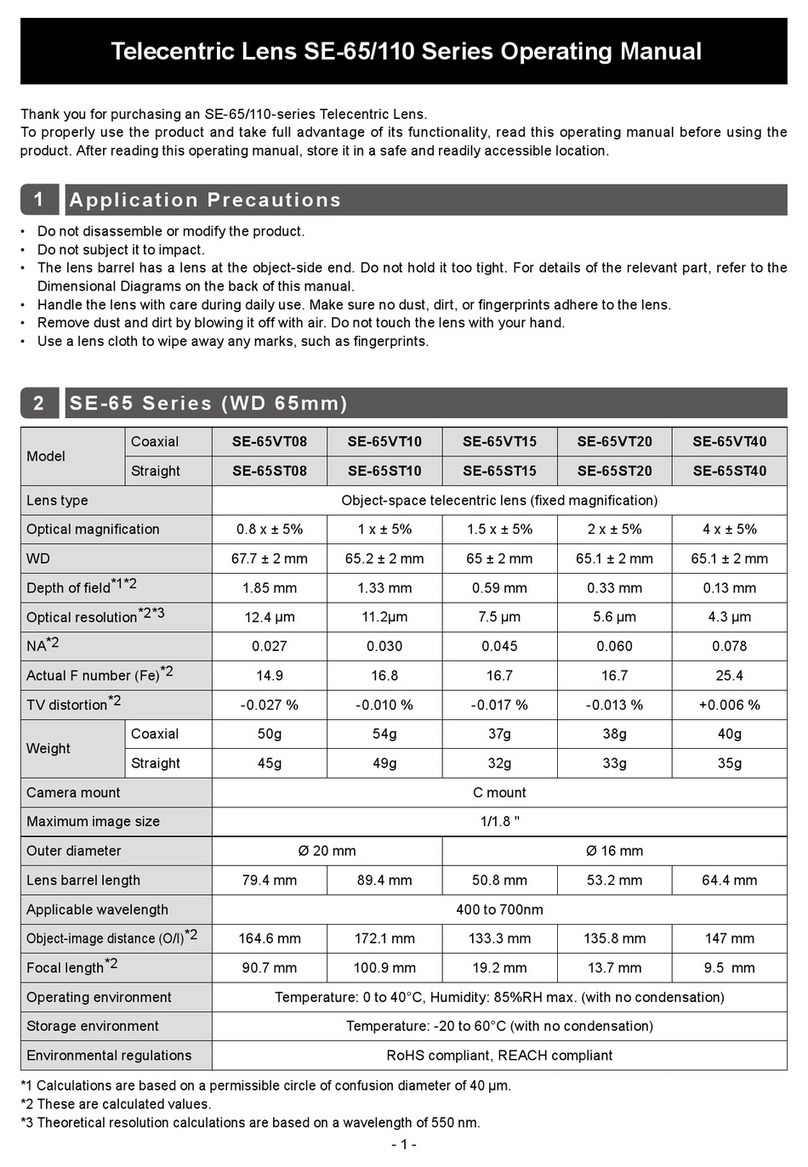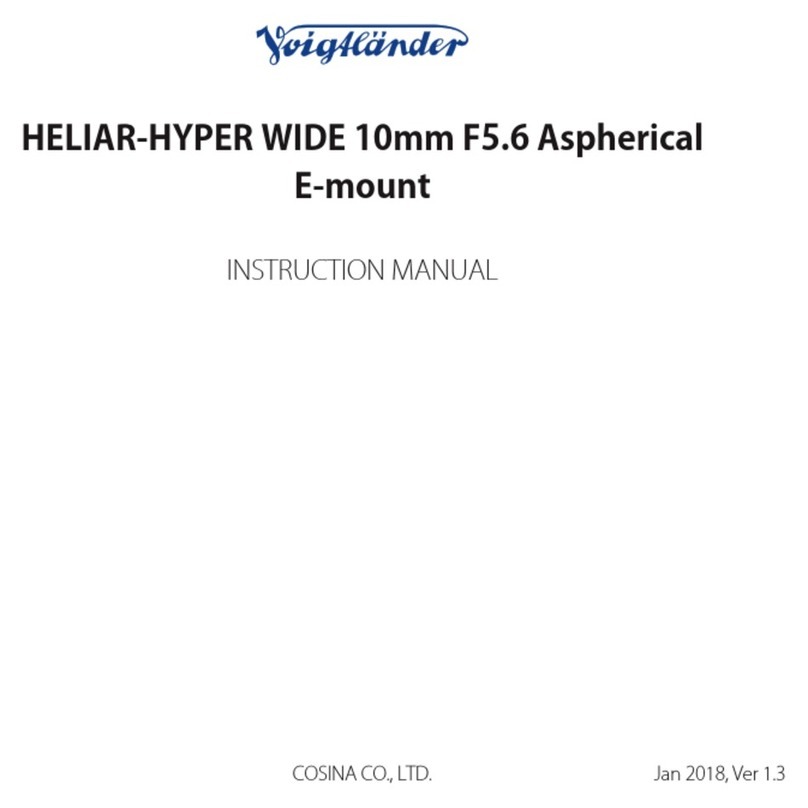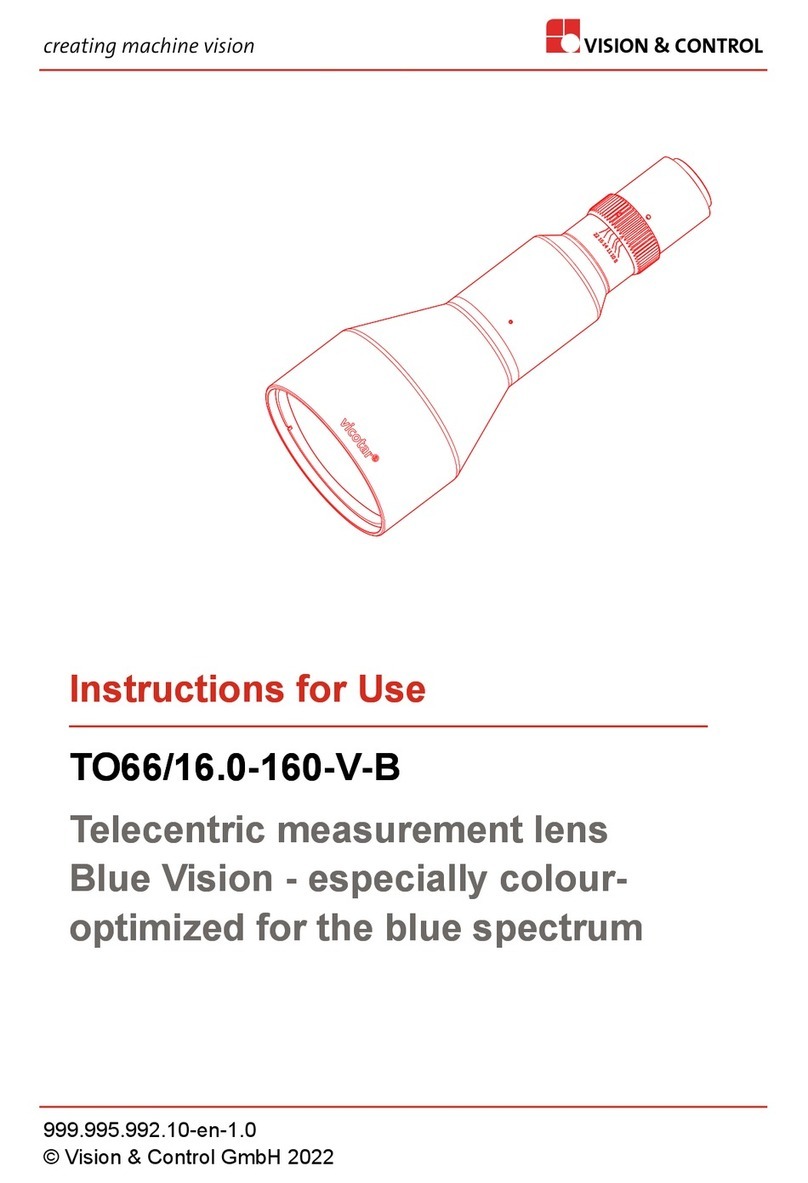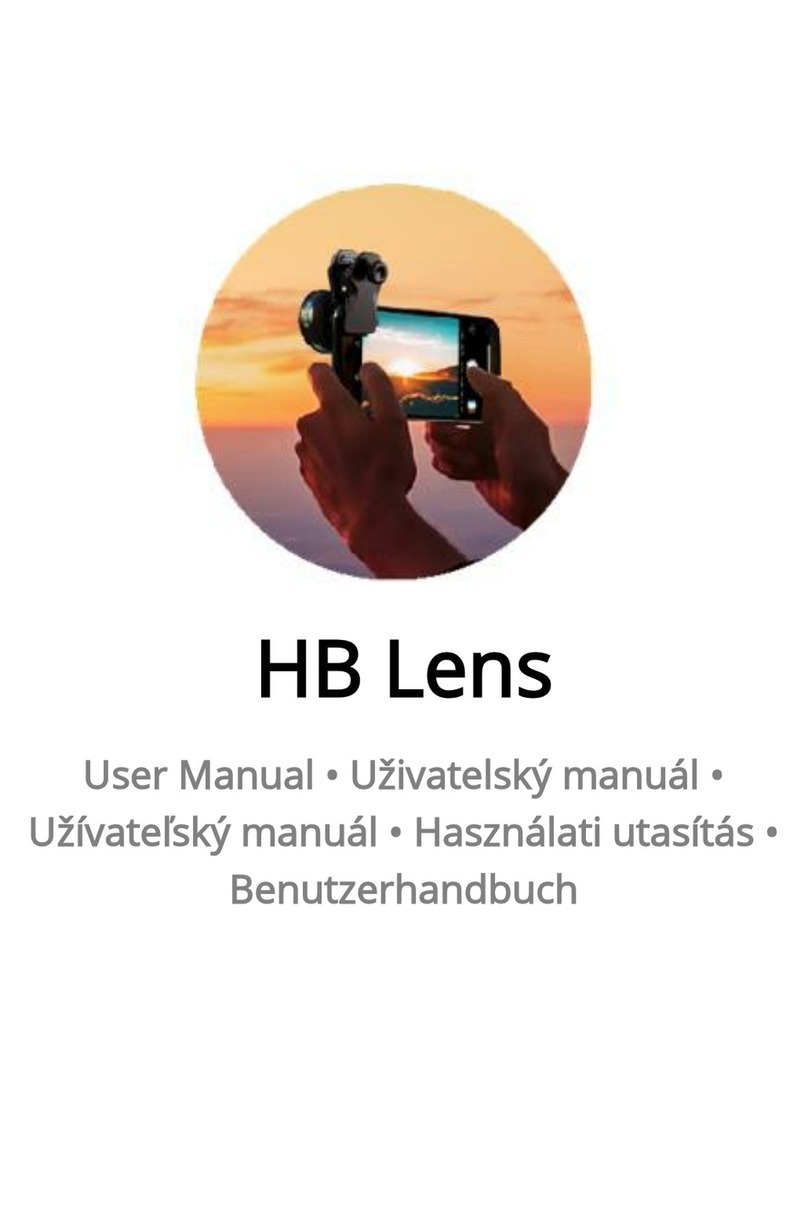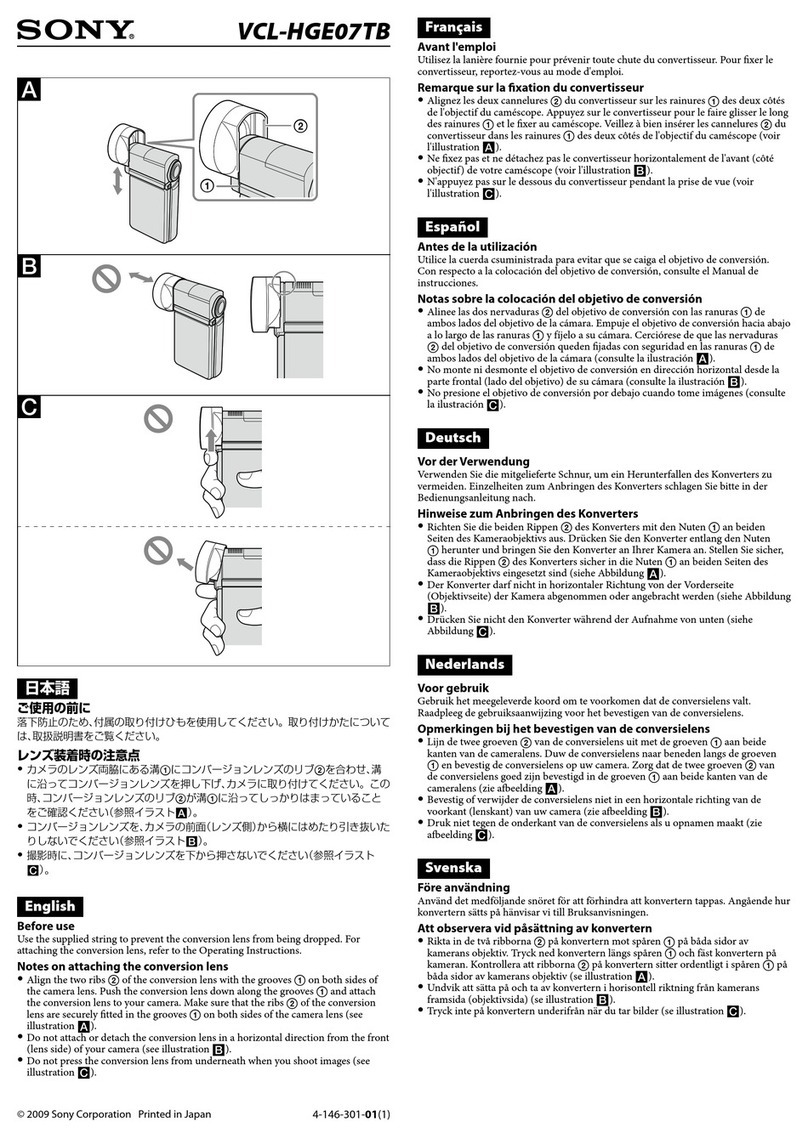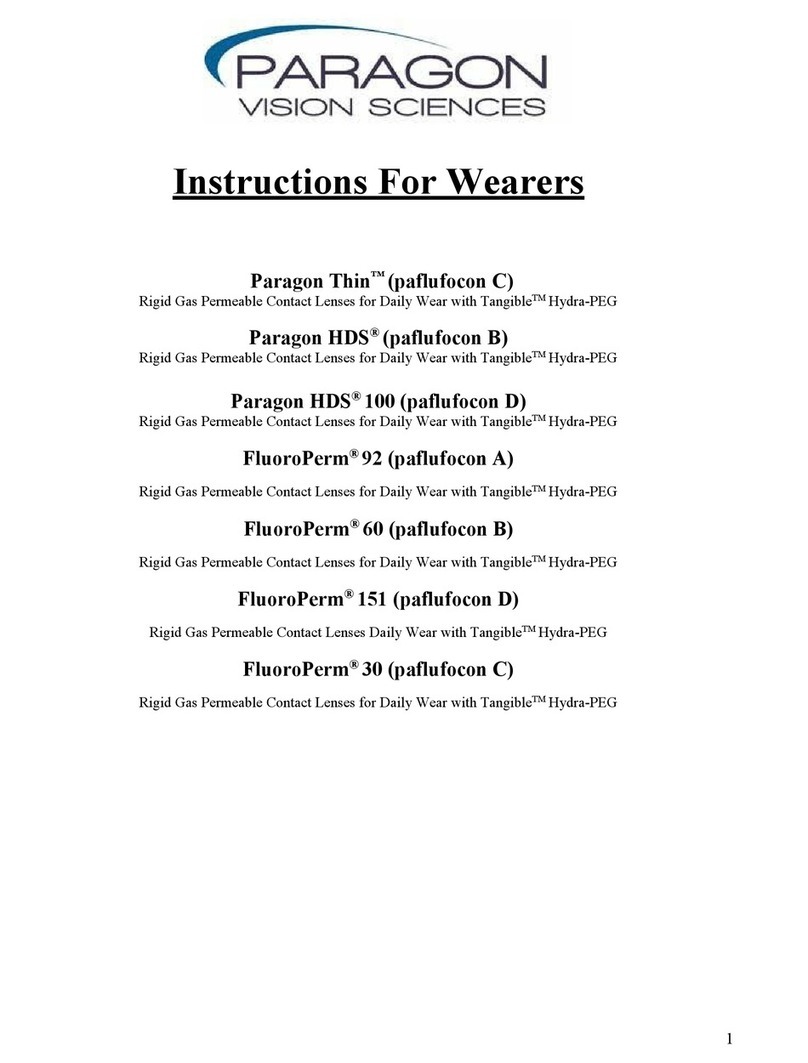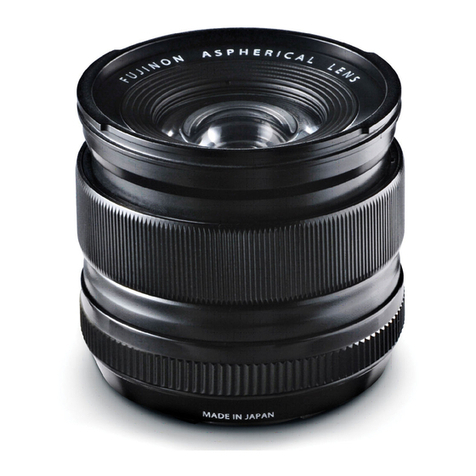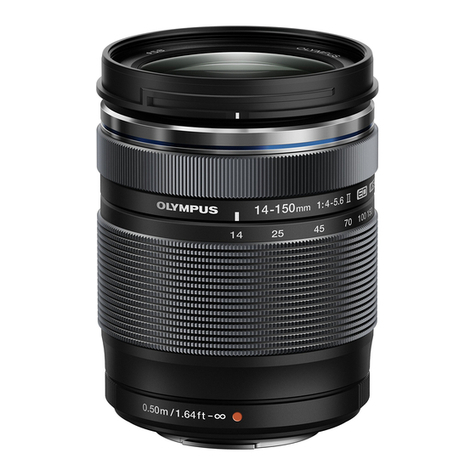Seed MonthlyFine UV-M User manual

Prepared in August 2018 (version 1)
SEED MonthlyFine UV-M
[Warnings]
1. Wearing contact lenses (“lenses” hereinafter ) may cause corneal
ulcers, keratitis (including infectious keratitis), corneal infiltration,
corneal epithelial disorders such as corneal erosion, corneal
edema, conjunctivitis (including giant papillary conjunctivitis), iritis,
and corneal neovascularization, and accelerate loss of corneal
endothelial cells.
If left untreated, eye disorders due to use of lenses may lead to
blindness.
2. To prevent eye disorders as listed above, observe the following
instructions in use of the lenses.
(1) Keep to the wear schedule.
The wear schedule differs for each individual. Follow the wear
schedule given by your eye doctor.
(2) Note the expiration date specified for your lenses.
These lenses are monthly replacement lenses. Replace the
lenses with new lenses at regular intervals as instructed by your
eye doctor. Check the expiration date to make sure the new
lenses have not expired.
(3) Use the lenses according to the procedures given.
Improper use of the lenses and lens care products may lead to
eye disorders. Keep the lenses and lens care products clean
(particularly the lens case). Handle carefully and use only as
instructed.
(4) Get regular contact lens checkups.
Note that eye disorders and lens damage may occur without
subjective symptoms. Get regular contact lens checkups as
instructed by your eye doctor even if you experience no problems.
(5) Consult your eye doctor immediately if you experience any
problems or notice anything unusual.
Confirm that your eyes are free of unusual redness or discharge
before inserting the lenses. No discomfort or irritation should
occur during use. If you experience discomfort or problems,
consult your eye doctor.
(6) Never use torn or otherwise damaged lenses.
Always inspect your lenses to confirm they are free of tears and
other damage. If you experience persistent symptoms that may
be due to lens damage, consult your eye doctor.
[Contraindications]
1. Contraindications (patients): Do not use the lenses if any of
the following occurs:
Acute or subacute inflammation in the anterior ocular segment
Ocular infection
Uveitis
Reduced corneal sensitivity
Dry eye or lacrimal apparatus disease affecting use of lenses
Abnormality of the eyelid
Allergic condition affecting use of lenses
Living or working in dry environments
Living or working in an environment where dust or chemicals are
likely to enter the eye
Unable to follow the recommendations of your eye doctor
Unable to use contact lenses properly
Unable to get regular checkups
Unable to adhere to the hygiene routine required to wear contact
lenses
2. Method for use
Do not wear someone else’s contact lenses or give your contact
lenses to someone else.
[Shape, structure, and principles]
1. Composition of the lenses
(1) Soft contact lens classification: Group I
(2) Monomer components: 2-HEMA, EGDMA
(3) Water content: 38%
(4) Oxygen permeability coefficient: 12 × 10-11 (cm2/sec)•(mLO2/(mL
× mmHg))
(5) Colorant: phthalocyanine colorant (color of lenses: blue)
(6) UV absorbing component: benzotriazole UV absorbing component
UV absorption rate: for diopter -3.00D
UV-A: ≥75%
UV-B: ≥95%
2. Storage solution
Major ingredients of the storage solution: Sodium chloride, borate buffer,
nonionic surfactant, EDTA, and alginate
3. Principle
These soft contact lenses are intended to correct vision based on optical
principles.
[Purpose of use or effect]
To correct vision
[Method of use]
Daily wear/monthly replacement/chemical disinfection
<Precautions for use>
1. Inserting/removing the lenses
(1) Lens handling precautions
• Keep your fingernails short and smooth.
• Wash your hands with soap before handling lenses.
• Do not dig your nail into the lenses or touch your eyes directly while
inserting or removing the lenses.
(2) Removing the lenses from the packaging
• Be careful to avoid cutting your hand against the packaging or label
while opening the container.
• Remove the lens gently from the packaging by pressing the lens
against the pad of your index finger. Be careful to avoid damaging the
lens. Alternatively, turn the blister packaging upside down and empty
the lens together with the storage solution into your parm.
• Inspect the lens to determine which lens is for the right eye and which
lens is for the left eye. Check to determine the inside and outside of the
lenses. The lenses should be free of any deformation.
(3) Inserting the lens
1) Place the lens on your index finger. Pull down
your lower eyelid with the middle finger of the
same hand and pull up on the upper eyelid with
the index finger of the opposite hand. Placing
your fingers on your eyelash line helps you
open your eye wider.
2) Look into the mirror so that the cornea comes
into the center of the eye. Slowly bring the lens
close to your eye and put it gently in place
while looking into the mirror. If you look upward
in this time, you cannot center the lens on the
cornea correctly.
3) When you have correctly placed the lens on the cornea, slowly
release your index finger and then release the fingers holding the
eyelids in the order of the lower eyelid and upper eyelid.
If you release your fingers quickly or blink, the lens may move or fall
out.
4) Check in the mirror to confirm that the lens is in front of the cornea.
Also, cover the opposite eye with your hand to check the vision in
your right and left eyes.
5) Follow the same procedure to insert the lens in your other eye.
(4) Removing the lens
1) Check the position of the lens in the mirror.
2) Facing forward, raise the mirror and examine
the eye in the mirror.
3) Gently pull your lower lid down and move the
lens down with the index finger of the same
hand.
4) In this position, gently take hold of the bottom
of the lens to remove the lens with the pads of
thumb and index finger.
Normal Inside out

2. Wear schedule
(1) These lenses are daily use lenses intended to be replaced monthly. Wear
your lenses only while awake. Remove the lenses before going to bed.
(2) The time required to become accustomed to the lenses varies from
person to person. Follow the instructions given by your eye doctor to
accustomize to your lenses at the optimal pace for you.
[Example of schedule]
Day
1
2
3
4 to 6
7 and thereafter
Hours
6
8
10
12
All waking hours
(12 to 14 hours)
(3) In cases in which contact lens use is suspended for:
• Less than a week: Start by reducing the time worn by 2 to 4 hours.
• A week or more: Start with the above schedule as in the first use.
• A month or more: Consult your eye doctor before resuming use of
contact lenses.
3. Lens care
Cleaning and disinfection is essential after using soft contact lenses.
Disinfect with chemical disinfectant. Proceed as follows:
• Gently and thoroughly rub both sides of the lens.
• Rinse the lens before wearing.
• Use all of the MPS within one month after opening.
• Do not reuse disinfectant.
• Do not transfer disinfectant to another container.
You must follow the detailed descriptions in Instruction for Use
(Package Insert) and Labeling.
4. Storing the lens case
• After using the lens case, dispose of the storage solution in the case,
thoroughly wash the lens case, and allow to dry.
• Replace the lens case with a new lens case at periodic intervals.
5. Regular checkups
Get regular checkups after one week, one month, three months, and then
every three months or as instructed by your eye doctor.
[Precautions]
1. Important basic precautions
(1) Carefully read these Instructions for Use before using your contact
lenses. Keep the Instructions in a safe place for future reference. You can
also view the Instructions for Use on the SEED website.
(2) Consult your eye doctor if you have an allergic disease. Allergic
conditions may increase the likelihood of adverse events.
2. Problems/adverse events
The following problems and adverse events may occur:
(1) Problems
Lens: Tearing, scratches, foreign matter (dirt), deformation
(bending), discoloration
Storage solution: Empty, discoloration/alteration
Package: Breakage, damage leading to leaks, fouling, wrong
number of lenses in packaging
(2) Adverse events
Corneal ulcer, corneal abscess, corneal perforation, corneal infiltration,
corneal erosion, keratitis, corneal epithelial disorders such as corneal
epithelial staining, corneal edema, corneal neovascularization,
conjunctivitis, subconjunctival hemorrhage, iritis, hordeolum, meibomitis,
chalazion, ptosis, accommodative asthenopia, dry eye, and loss of
corneal endothelial cells
*Package labeling
P
Power
STERILE
Sterilized using steam or dry heat
BC
Base curve
紙
Package material: paper
DIA
Diameter
プラ
Package material: plastic
Batch code
Use by date
<Symptoms and countermeasures>
• Do not use forcibly if your eyes are not in good condition or you are
unwell.
• Try the following countermeasures if you experience any of the
following symptoms while using the lenses. If symptoms persist,
consult your eye doctor immediately.
Symptoms
Countermeasures
Foreign body sensation,
pain, itching, clouding,
unusual eye discharge,
and unusual redness of
the eyes
• Check the lenses. Replace with new lenses if
they appear torn or otherwise damaged.
• If the lens appears dirty, gently rub and rinse
the lens.
• If the symptoms occurred after extended
periods of wear, try wearing them for shorter
periods.
Unstable visual acuity,
difficulty in seeing, and
eye strain
• Check which lens is for the left eye, which lens
is for right, and inside/outside of the lenses and
reinsert the lenses correctly.
• If the lens appears dirty, gently rub and rinse
the lens.
• If the symptoms occurred after extended
periods of wear, try wearing them for shorter
periods.
Feeling of dryness
• Blink several times to produce more tears.
• Use eye drops for soft contact lenses.
3. Use by pregnant, parturient and breastfeeding women and children
(1) If you use medication or eye drops, if you are pregnant, or if you have
just given birth, consult your eye doctor. Your condition may affect lens
use.
(2) A child should use their lenses under supervision of parents.
4. Use by elderly persons
For use by elderly persons or persons who have difficulty handling the
lenses themselves, consult an eye doctor for appropriate instructions.
5. Other precautions
(1) Take spare lenses and glasses with you in case you lose or have to
stop using the lenses.
(2) Before traveling abroad, check conditions at your destination and bring
the lenses and lens care products required or determine how to buy
them there.
(3) Put on make-up after putting on the lenses and remove the make-up
after removing the lenses.
(4) Do not allow cosmetics to come into contact with the lenses.
(5) It is advisable to use artificial tears, without preservatives, for soft
contact lenses while wearing the lenses. Other eye drops should be
used under instructions of your eye doctor.
(6) Remove the lenses before swimming.
(7) Wear contact lenses when driving or operating machinery only after
you become accustomed to wearing them.
If a lens dislodges or falls out while you are driving or operating
machinery, stop driving or operating the machinery promptly after
making sure that it is safe to do so.
(8) If your eyes are exposed to strong wind, use some form of protection
against wind (e.g., goggles).
(9) If you get anything in your eye while wearing the lenses, immediately
remove them. Consult your eye doctor if you notice symptoms.
(10) Do not wear one lens on top of another lens.
[Storage and expiration]
1. Storage: Store at room temperature. Avoid exposure to direct sunlight
and freezing temperatures.
2. Expiration date: The expiration date of the lenses is indicated on the
outer carton and packaging container. Open the package and use
before the expiration date.
Example: 2023-08 means “Expires in August 2023.”
[Name of Marketing Authorization Holder and Manufacturer]
<Marketing Authorization Holder>
SEED Co., Ltd.
2-40-2 Hongo, Bunkyo-ku, Tokyo
Phone (switchboard): 03-3813-1111
[Contact information]
<Inquiries about symptoms>
For symptoms related to use of the contact lenses, consult the eye
doctor who prescribed the lenses.
<Product inquiries>
We make every effort to ensure quality. However, if you should find any
abnormality in the lens or packaging, keep the product without using it
and consult your eye doctor or supplier.
This manual suits for next models
1
Other Seed Lens manuals
